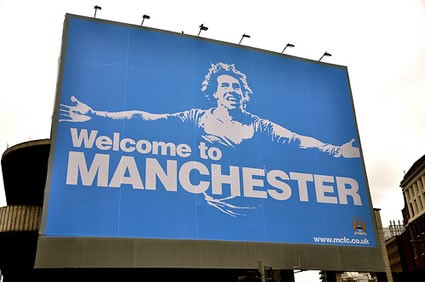| ‘Boys, listen, we’re gonna have the dinner party on Tuesday night, okay?’
‘Um… we can’t do Tuesday, biggest game of the season’s on.’ ‘We can do it Wednesday then.’ ‘No, sorry, biggest game of the season Wednesday night.’ ‘But…’ While the logic to our argument over the two Champions League semi-finals, on consecutive nights in early May, was completely baffling to those of the female persuasion, we weren’t that far off the mark for a great number of football fans. The ‘biggest game of the season’ happens twice (perhaps, depending on cup competitions, several times more) a season. Derby day at home; derby day away. I remember being told by Newcastle fans that seasons are defined and remembered not by league positions or even cup runs, but by results in the Tyne-Wear derby, against North-east neighbours Sunderland. You’d take finishing 15th and winning both derbies over finishing 5th and losing them. This evening, it’s one of global soccer’s fiercest rivalries, the Derby della Madonnina. AC vs Inter, in front of 80,000 fervent Milanese, at the San Siro. I had the privilege of being there to see the ‘Nerazzurri’ in black and blue defeat the ‘Rossoneri’ in black and red, 2-1, in December 2007. The city centre was almost ominously silent in the morning of the game, the fans found swarming around the stadium, which rises up like a spaceship of enormous proportions, in the west of the city. You couldn’t move amongst the cars, or hear over the car horns. Inside the ground, the stands are incredibly steep. Although the flares that used to so illuminate Italian games had by then been banned, the competing ‘ultras’ behind either goal displayed massive banners and prodigious chanting. The action on the pitch – a game of chess punctuated by sharp flashes of elegant brilliance – wasn’t bad either. As for tonight’s match, AC will be desperate to gain revenge after suffering a 0-4 mauling when they were technically at home in August. Inter lead their rivals by six points at the top of Serie A, but with coach Jose Mourinho’s future less than certain, they have stuttered in recent weeks. AC on the other hand, with Ronaldinho firing again, have been little less than rampant since returning from the Christmas break. Should be a corker. The biggest game of the season in England doesn’t usually come in January. Or in the Carling Cup, a competition popularly derided in recent seasons, the big boys putting out youth sides a reflection of how low it sits on their priority lists. But, with a rejuvenation of the Manchester rivalry that had somewhat mellowed in recent years, Wednesday night’s Carling Cup semi-final second leg at Old Trafford is right up there. The two clubs first met in 1881, although neither had their ‘Manchester’ names back then. Their match-ups in the early 1970s were of particular intensity, though a display of sentiment from one player who crossed the divide has lived longest in the memory. Denis Law, a United goalscoring great, was at City by the time the pair met in April 1974. In the penultimate game of the season, Law scored the goal that relegated his former side, and, head bowed, immediately left the pitch, never to play professionally again.
United’s supremacy has long been assured, that is, until Sheikh Mansour turned up and splashed the cash to turn City into genuine title contenders. Carlos Tevez moved from the red to the blue half of the city in the summer, a banner famously proclaiming ‘Welcome to Manchester’. In their first meeting of the season, in September, Michael Owen scored an injury-time winner in a seven-goal thriller described by Sir Alex Ferguson as probably ‘the best derby of all time’. And then last week, Tevez scored both of City’s goals as they secured a 2-1 first-leg advantage, and celebrated by cupping his ears in the direction of the United dug-out. Gary Neville stuck a middle finger up, and Tevez later labelled him a ‘moron’ and a ‘boot-licker’. Wednesday’s re-match promises to be tasty. Graeme Souness is a man who knows all about the derby, having made telling, if ill-considered, contributions to two of world soccer’s greatest. The ‘Old Firm’, played between Glasgow’s Celtic and Rangers since 1888, has the add element of sectarian rivalry. Rangers fans are traditionally Protestant, and loyalists in terms of Northern Irish politics. Celtic are historically associated with Irish Catholicism, and their fans regularly sing provocative Irish Republican songs. But in June 1989, whilst managing Rangers, Souness broke their ‘unwritten policy’ of not signing Catholics on capturing Mo Johnston, who days earlier was poised to re-sign for Celtic after a spell away in France. A number of Catholics have since played for Rangers. Souness moved to Istanbul, a unique city that straddles the Bosphorus Strait in both Europe and Asia. Its principal sides, Galatasaray, from the European side, and Fenerbahce, from the Asian, have a fierce, unrelenting rivalry. He was managing Galatasaray when, after they beat their local adversaries after extra time in the Turkish Cup final of 1996, he grabbed a Galatasaray flag and planted it in the centre circle of Fenerbahce’s pitch. Needless to say, the home fans weren’t overly impressed. Souness spent the last three weeks of his time in Turkey – before he was sacked – with a 24-hour security guard. Class distinctions form an important part of many city rivalries. Fenerbahce traditionally have a working-class fan base, compared to their sophisticate rivals. The ‘Derby of the eternal enemies’, Olympiacos vs Panathinaikos, of Athens, most strongly epitomises class-based animosity. Panathinaikos were formed in 1908 in the high society of the city centre, while Olympiacos were established in 1925, their fans from the working class port, and quickly attracted support from all over, amongst those who saw themselves as victims of social injustice. The ‘Eternal derby’ label continues throughout Eastern Europe. Levski and CSKA Sofia meet at the national stadium rather than their own grounds to allow for increased attendances, while the colourful flares of Steaua and Dinamo fans illuminate Bucharest derbies. Partizan and Red Star Belgrade’s ‘Eternal derby’ might just be the pick of the bunch, the animosity between Partizan’s ‘Grobari’ and Red Star’s ‘Delije’ fans continuing into a number of other sports contested between the pair. ‘Superclasico’ is the name for the derbies of South America, where the meeting of Buenos Aires’ top two – Boca Juniors and River Plate – steals the show. Between them, the two command 70% of support inside Argentina, and the sights of matchday include confetti and toilet roll strewn across the pitch. Rated as one of the greatest sporting spectacles in the world, you can see it for less than $10. The ‘Fla-Flu’ derby of Rio de Janeiro, Brazil, can’t come too far behind. Flamengo and Fluminese first met in 1912, after a group of dissatisfied Fluminese players left and formed their own club. They took advantage of the state’s enormous Maracana stadium, and, in December 1963, played a derby which, officially, 177,000 attended. The number was probably closer to 195,000 in reality, and no trouble was had. Uruguay’s ‘Superclasico’ has pitted Montevideo’s Nacional and Penarol together since 1900. They have squared of 493 times since, in what is the longest-running derby duel outside of Britain. The Birmingham, or ‘Second city’, derby is perhaps the oldest in soccer, Aston Villa and Birmingham City having first faced-off in 1879. The ‘Steel City’ derby between Sheffields United and Wednesday comes not too far behind. On Merseyside, Everton originally played at Anfield, which they rented from local brewer John Houlding. In 1889, he hiked up the rent, and the Toffees left. Houlding formed Liverpool FC to play there instead, and the pair first met in 1894. Less than a mile apart in the north of the city, the pair have enjoyed a friendly rivalry, highlighted when Evertonians joined in the boycotting of The Sun after the Hillsborough tragedy. With both clubs struggling to find the money to invest in much-needed new stadia, a suggested ground-share has been opposed with strong words. I think that, as continental examples show, sharing a stadium would not take anything away from the clubs’ identities, only adding to a healthy rivalry. Unfortunately, the ferocity of the derby has often had violent consequences, most notably encapsulated by the Derby della Capitale, between Roma and Lazio, in Rome. Benito Mussolini founded Roma from an amalgamation of capital clubs in 1927, in an effort to take on the northern sides. Lazio resisted, and they played for the first time in 1929. Roma supporters are traditionally from left-leaning southern Rome, and occupy the Stadio Olimpico’s Curva Nord, their Lazio counterparts on the Curva Sud generally wealthier and traditionalist. On derby-day, March 2004, riots began inside the ground when rumours spread of a young fan being killed by police outside. Three ultra leaders walked onto the pitch, issuing death threats to Roma captain Francesco Totti unless the game was called off. After play was suspended, police and fans battled into the night, 170 policemen eventually injured. The false rumours had been an excuse to go on a rampage; a display of the ultras’ power. Recently, in December 2009, the referee stopped play for seven minutes after fireworks were thrown onto the pitch. Mes que un club, reads the words on the seats of Camp Nou, Barcelona. Barça is more than a club; she stands for Catalonian identity, and at no point more than during ‘El Clasico’, against the club that most come to represent the Spanish state, Real Madrid. Especially during the Franco era, their matches were focus points not for any kind of city-wide rivalry, but ethnic separatism and nationalism. Both clubs have competed for high-profile signings on a number of occasions, most notably with Alfred di Stefano in the 1950s. Both thought they had signed the Argentinean, FIFA ruled they could share him, Barcelona backed down and di Stefano drove Real to win the first five European Cups. In 2000, Luis Figo defected from Barcelona to Real to become the first Galactico. The rivalry – first played out in 1902 – burns ever stronger. Finally, there’s Philadelphia Union, who had rivals even before they became a team. The Sons of Ben were formed in January 2007, aiming to agitate for the formation of a Philadelphia MLS team. The Union were confirmed as the league’s sixteenth side for 2010 in February 2008, and will play in the new soccer-specific Union Field at Chester, Pennsylvania. Their big rivals will be the New England Revolution, after the Sons of Ben – a supporters group who had no team to support – went to New England games to drum up a rivalry. Tom Sheldrick is a freelance writer and can be reached at: tomsheldrick@hotmail.com |
Your Soccer Resource Center















